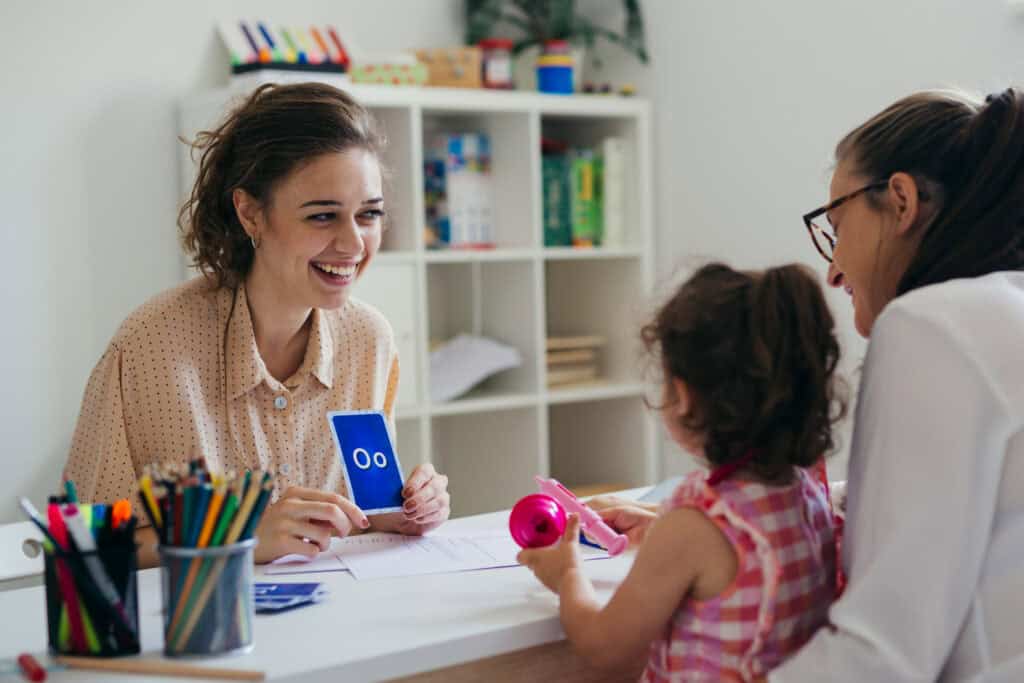To enhance your emotional connection with your child, focus on seven essential communication skills. Start with active listening to truly understand their thoughts and feelings. Use empathetic responses to validate their emotions, building a strong bond. Encourage deeper discussions with open-ended questions. Pay attention to nonverbal communication, as body language and facial expressions matter.
Implement positive reinforcement to boost their self-esteem and behavior. Practice emotional validation to help them feel accepted. Finally, develop conflict resolution skills that emphasize collaboration and empathy. These approaches can transform your interactions, and there’s more to discover about nurturing connections.
Active Listening
Active listening is essential for understanding your child’s thoughts and feelings, helping you connect with them on a deeper level. When you practice active listening, you create an environment where your child feels safe to express themselves. This involves more than just hearing their words; it requires your attentive presence. Show them you’re genuinely interested by maintaining eye contact and nodding to acknowledge their feelings.

Reflective listening is a key component of active listening. It means you paraphrase or summarize what your child has said to guarantee you understand their perspective. For example, you might say, “It sounds like you’re feeling frustrated because you couldn’t play with your friends today.” This not only validates their emotions but also encourages them to share more.
Empathetic Responses
Understanding your child’s emotions is essential for building a strong connection. By using active listening techniques, you can respond empathetically and show that you truly care about what they’re feeling. This not only helps them feel heard but also strengthens your relationship.
Understanding Children’s Emotions
Recognizing your child’s emotions is essential for building a strong, trusting relationship and providing the support they need. By developing your emotional intelligence, you can better understand and respond to your child’s feelings, leading to improved behavior and emotional well-being.
To enhance your empathetic responses, consider the following:
- Observe body language: Pay attention to your child’s facial expressions and posture; these cues can indicate their emotional state.
- Name their feelings: Use language to label what they might be feeling—like “I see you’re frustrated”—to validate their emotions and show you care.
- Share your own experiences: Relate to your child’s situation by sharing a similar feeling you’ve had, fostering a sense of connection and understanding.
Active Listening Techniques
Listening attentively to your child not only shows you care but also strengthens your bond and helps them feel heard. Active listening is essential in overcoming listening barriers that can arise due to family dynamics. When you practice empathetic responses, you create a space where your child feels safe to express their feelings.
Here are some empathetic responses to enhance your listening skills:
| Empathetic Response | Effect on Child |
|---|---|
| ‘I can see you’re upset.’ | Validates their feelings. |
| ‘That sounds really tough.’ | Shows understanding and empathy. |
| ‘Tell me more about it.’ | Encourages deeper conversation. |
| ‘It’s okay to feel that way.’ | Normalizes their emotions. |
| ‘I’m here for you.’ | Reassures them they’re not alone. |
Open-Ended Questions
As a parent, asking open-ended questions can truly transform your conversations with your child. These types of questions encourage deeper discussions, foster emotional expression, and promote active listening. By using them, you create a safe space for your child to share their thoughts and feelings more freely.
Encourage Deeper Conversations
Open-ended questions can transform everyday conversations with your children into opportunities for deeper understanding and connection. Instead of simple yes-or-no questions, ask questions that encourage your kids to express themselves. This approach not only reveals their thoughts but also fosters meaningful dialogues, leading to deeper insights about their feelings and experiences.
Consider these strategies:
Ask about their day: Instead of “Did you have a good day?”, try “What was the best part of your day?” This opens the door for a richer conversation.
Explore their interests: Instead of “Do you like that game?”, ask “What do you enjoy most about playing it?” This invites them to share their passions.
Encourage reflection: Rather than “Are you happy?”, pose the question “What makes you feel happy?” This encourages them to think more deeply about their emotions.
Foster Emotional Expression
How can you create a safe space for your children to share their feelings and emotions? Start by using open-ended questions that encourage them to express themselves freely. Instead of asking, “Did you have a good day?” try, “What was the best part of your day?” This approach invites deeper conversation and helps your children build their emotional vocabulary.
When you ask questions that require more than a simple yes or no, you empower your kids to articulate their thoughts and feelings. You might say, “How did that make you feel?” or “What do you think about that situation?” These prompts can lead to meaningful discussions that foster emotional expression.
Encourage your children to engage in creative expression as well. Activities like drawing, writing, or even role-playing can help them convey emotions in ways that words sometimes can’t. By combining open-ended questions with creative outlets, you create an environment where your children feel safe to explore their emotions. Remember, the goal is to validate their feelings and show them that it’s okay to express themselves. This practice not only strengthens your bond but also nurtures their emotional intelligence.
Promote Active Listening
Promoting active listening in your conversations with children involves asking thoughtful questions that invite them to share their thoughts and feelings openly. By using open-ended questions, you can encourage deeper dialogue and help them express themselves more freely. This approach can also help overcome listening barriers, such as distractions or misunderstandings, that might arise due to cultural influences or differing communication styles.
To foster active listening, consider these strategies:
- Ask questions that spark curiosity: Instead of yes/no questions, try, “What was the best part of your day?”
- Encourage elaboration: Follow up with, “Can you tell me more about that?”
- Show genuine interest: Use affirmations like, “That sounds interesting!” to validate their feelings.
Nonverbal Communication
Nonverbal communication plays an essential role in how you connect with your children, as it often conveys emotions and intentions more powerfully than words alone. Your body language and facial expressions can make a significant impact on the way your child perceives your feelings and intentions. When you smile genuinely, your child feels welcomed and loved. Conversely, crossed arms or a frown might create a barrier, making them feel insecure or misunderstood.
Being aware of your nonverbal cues is vital. For instance, maintaining eye contact shows your child that you’re engaged and interested in what they’re saying. You can also use gestures to reinforce your message, making it more relatable and clear for them.
When you embrace open body language, you create a safe space for your child to express themselves. It’s important to be mindful of your tone and expressions, as they can either encourage or discourage open dialogue. By consciously aligning your nonverbal signals with your messages, you foster a deeper emotional connection, helping your child feel seen, heard, and valued.
Positive Reinforcement
Using positive reinforcement can considerably enhance your child’s behavior and self-esteem, creating a nurturing environment for their growth. By focusing on what your child does well, you provide valuable behavioral feedback that encourages them to repeat those positive actions. This approach fosters a sense of accomplishment and belonging, essential for their emotional development.
To effectively implement praise strategies, consider these tips:
- Be Specific: Instead of just saying “good job,” highlight what they did well, like “You did a great job sharing your toys!”
- Timeliness Matters: Offer your praise right after the behavior you want to reinforce. This helps your child connect the positive feedback with their actions.
- Celebrate Efforts: Recognize hard work and determination, not just the end result. This encourages resilience and a growth mindset.
Emotional Validation
While positive reinforcement builds your child’s confidence, emotional validation helps them feel understood and accepted in their feelings. By practicing emotional validation, you create a safe space for your child to express their emotions, fostering emotional literacy. This means they learn to recognize and articulate their feelings, which is essential for their emotional development.
To use effective validation techniques, start by listening actively and empathetically. Acknowledge their feelings without judgment. Phrases like, ‘I can see you’re really upset,’ or ‘It’s okay to feel that way,’ can make a significant difference. This shows your child that their emotions are valid and important, encouraging them to open up further.
Conflict Resolution Skills
Every parent encounters conflicts with their children, making it essential to develop effective conflict resolution skills that foster understanding and cooperation. By honing these skills, you can create an environment where both you and your child feel heard and valued.
Here are some strategies to evaluate:
- Active Listening: Pay close attention to your child’s feelings and needs without interrupting. This helps them feel understood.
- Negotiation Strategies: Approach conflicts as opportunities for collaboration. Encourage your child to express their viewpoint, and together, brainstorm solutions that work for both of you.
- Compromise Techniques: Teach your child the importance of give-and-take. Sometimes, both sides need to adjust their positions for a harmonious resolution.
Incorporating these techniques not only resolves immediate issues but also builds a foundation for future discussions. Remember, the goal isn’t to win an argument but to nurture a loving relationship. By practicing empathy and patience, you can guide your child toward conflict resolution, helping them develop these essential skills for their own future interactions.
